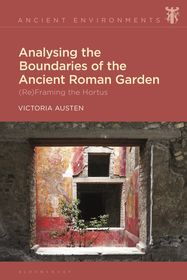
Analysing the Boundaries of the Ancient Roman Garden
(Re)Framing the Hortus
Series: Ancient Environments;
- Publisher's listprice GBP 85.00
-
40 608 Ft (38 675 Ft + 5% VAT)
The price is estimated because at the time of ordering we do not know what conversion rates will apply to HUF / product currency when the book arrives. In case HUF is weaker, the price increases slightly, in case HUF is stronger, the price goes lower slightly.
- Discount 13% (cc. 5 279 Ft off)
- Discounted price 35 330 Ft (33 647 Ft + 5% VAT)
Subcribe now and take benefit of a favourable price.
Subscribe
40 608 Ft

Availability
printed on demand
Why don't you give exact delivery time?
Delivery time is estimated on our previous experiences. We give estimations only, because we order from outside Hungary, and the delivery time mainly depends on how quickly the publisher supplies the book. Faster or slower deliveries both happen, but we do our best to supply as quickly as possible.
Product details:
- Publisher Bloomsbury Publishing (UK)
- Date of Publication 9 March 2023
- Number of Volumes Hardback
- ISBN 9781350265189
- Binding Hardback
- No. of pages224 pages
- Size 236x162x16 mm
- Weight 480 g
- Language English
- Illustrations 30 bw illus 444
Categories
Long description:
This book demonstrates how the Romans constructed garden boundaries specifically in order to open up or undermine the division between a number of oppositions, such as inside/outside, sacred/profane, art/nature, and real/imagined. Using case studies from across literature and material and visual culture, Victoria Austen explores the perception of individual garden sites in response to their limits, and showcases how the Romans delighted in playing with concepts of boundedness and separation.
Transculturally, the garden is understood as a marked-off and cultivated space. Distinct from their surroundings, gardens are material and symbolic spaces that constitute both universal and culturally specific ways of accommodating the natural world and expressing human attitudes and values. Although we define these spaces explicitly through the notions of separation and division, in many cases we are unable to make sense of the most basic distinction between 'garden' and 'not-garden'. In response to this ambiguity, Austen interrogates the notion of the 'boundary' as an essential characteristic of the Roman garden.
Table of Contents:
List of Figures
Acknowledgements
Introduction: Defining Garden Space
Chapter 1: Setting the Framework
Chapter 2: Who has the time? Virgil, Columella, and Hortus Poetry
Chapter 3: Augustus' Garden Room? Re-Framing the Ara Pacis Augustae
Chapter 4: Distinguit et Miscet: Framing Roman Villa Gardens
Conclusion: Seneca's Thyestes and the Anti-Garden
Notes
Bibliography
Index




